
Ancient tower guarding the Military Georgian Road, Georgia
Caucasus on Fire.
The mountains of Caucasus were once among the most rewarding
regions for a traveler. Their unique ethnic (62 languages belonging to 5 major
families), and cultural diversity could be comfortably enjoyed and studied together
with beautiful nature and great collection of historical monuments. Unfortunately,
the violent history of the region has never come out of the age of tribal clashes,
blood feuds and colonial wars. It became worse than ever three hundred years ago,
when Turkey and Persia, two long-time enemies of local people, were joined by
Russian Empire - the most dangerous predator in that part of the World. Russian
invasion destroyed the unique civilization of Northern Caucasus; and the struggle
for influence between the regional superpowers has fueled conflicts between Christian
and Muslim ethnical groups. Later, genocide and forced displacements have turned
the area into one large political minefield, with 4 ongoing and 20-30 potential
ethnic conflicts. Still, the Caucasus is so interesting that some people risk
visiting it. Few of them fall victims to street crime or large-scale hostage business,
but others find surprising hospitality and peaceful lifestyle.

Tviberi Pass between
Svanetia and Balkaria. |
The Main Ridge of Caucasus is a formidable barrier
between Russian-occupied Northern Caucasus and the independent states of Transcaucasia.
Few roads cross it, such as the old Military Georgian Road. Russian troops built
it in the 1850-s. It is currently the most safe and reliable surface route from
Russia to Transcaucasia. It passes through spectacular Darial Gorge, and then
close to Kazbek (5033m/16,800') - the ridge's second highest mountain. Kazbek
and Elbrus (5642 m/18,800') are both active volcanoes, but they haven't erupted
in the last 500 years, so locals think they are extinct. |

Anti-avalanche artillery,
Military Georgian Road. |

View from Elbrus summit. |
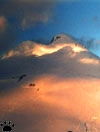
Final approach to
Kazbek summit. |
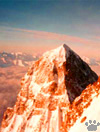
View from Mt.Ushba
(4710m/15,700'). |
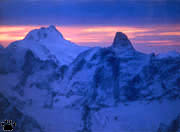
Shhelda Ridge, Balkaria. |

Chechen tower,
Shali, Ichkeria. |
Along both sides of the Ridge, there are hundreds
of isolated valleys. Some of them are pristine nature reserves,others shelter
old colorful auls (villages). In some auls, each house has its own tower,
where the family could defend itself in times of war. Auls of Ichkeria (Chechnya)
used to be among the most beautiful, but many of them are being destroyed by Russian
army, as this tiny republic fights for its freedom after many decades of cruel
occupation and periodic genocide. |

Inguri Canyon,
Imeretia, Georgia. |
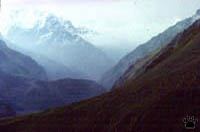
Darial Gorge, Osetia, Russia. |

Ancient churches, Mt.Kazbek. |
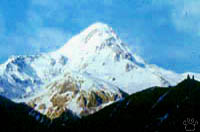
Mt. Kazbek, Hevsuretia, Georgia. |
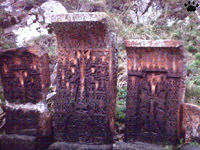
Tombstones, 6th century, Vedi, Armenia. |
Some local ethnic groups have been living at their
present location for many centuries, using the same cemeteries and pastures. |

Cemetery, 3-20th centuries, Derbent, Dagestan. |
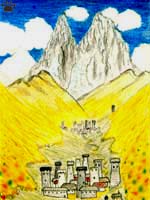
Ushguli Village and Mt. Ushba
(4700m/15,660'), Svanetia, Georgia. |
My favorite part of the
ridge is Upper Svanetia in north-western Georgia. In Ushguli and other local villages,
all houses and towers are at least 500 years old. The lifestyle hasn't changed
much, too. Tiny Svanetian churches are particularly unique - some are decorated
with medieval silver casting, not with painted icons.West from Svanetia are some
of the best-preserved natural areas in Asia, such as the huge Kavkazski Zapovednik
(Caucasus Nature Reserve), famous for outstanding fall
colors and floral diversity. |
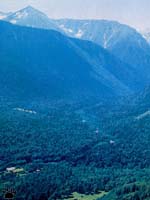
Forests of Kavkazski Zapovednik,
Russia near Abkhazian border. |

Crocus vernus and Galanthus caucasicus, Kavkazski
Zapovednik. |

Crocus tomasianus, Kavkazski Zapovednik. |
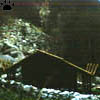
Rekom - "male temple",
Tsei, Osetia. |
On the northern side, Osetia and Dagestan are
the most interesting. Osetians are direct descendants of the ancient Skiffs. They
speak almost unchanged Skiff language (Iranian group), and worship a strange assembly
of Christian and Pagan deities. Dagestanians are Muslims, and they speak 32 different
languages. Tabasaran and other remote parts of Dagestan are the best places to
see ancient Highland culture. |
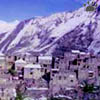
Nehtlib aul (village),
Tabasaran, Dagestan. |

Rock bunting (Emberiza
cia), Shkhelda Mt.,
Balkaria, Russia. |
Forests and meadows of the Main Ridge are among the few places
in CIS where you can still see large herds of wild animals. There are also hundreds
of endemic plant and insect species, and some birds and mammals that live only
in these mountains. Among the most interesting are three species of ibex (Capra),
odd rodent called Prometheomus shaposhnikovi, endemic grouse (Tetrao
mlokosevichi), and snowcock (Tetraogallus caucasicus). |

Brambling (Fringilla
montifringilla), Dagger
Mt., Karachai, Russia. |
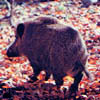
Wild boar (Sus
scrofa), Teberda,
Cherkessia, Russia. |
Few hundreds of European bison,
and few remaining leopards of the largest subspecies (Pantera pardus saxicola),
also live in nature reserves of the Main Ridge.

East Caucasian ibex (Capra cylindricornis), Rutul, Dagestan. |
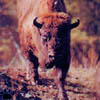
European bison
(Bos bonasus), Dombai,
Cherkessia, Russia. |
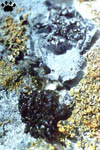
Lichens at 4500m,
Mt. Ushba, Russia. |
New species of plants and animals are often
described not only from the more remote parts
of Caucasus, but also from well-studied areas.

Widespread lizard
Lacerta media,
Hosta, Russia. |

Rare snowdrops
Galanthus kemularia,
Varenikovskaya, Russia. |

Recently described viper
Vipera darevskii,
Kabarda, Russia. |
|

Undescribed lichen,
Mt. Elbrus, Russia. |
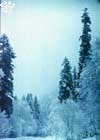
Firs Abies nordmanni,
Caucasus Reserve. |
Some parts of Western Caucasus get so much snow
that the snow cover can reach 30 m (100').In 1987, the snowfalls
were so heavy that avalanches destroyed hundreds of villages, and some thousand
years-old Svanetian towers. I was lucky to be in the area at this time, and to
see the ancient forests packed with snow up to treetops. From a rescue helicopter
flying to some remote village, we could sometimes see up to 3 mega-avalanchesat
the same time. |
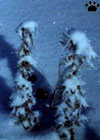
Snow on the grass,
Abkhazia. |
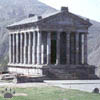
Garni Temple,
2nd century B.C.,
Armenia. |
Fertile subtropical valleys of Transcaucasia had
attracted conquerors long before Turkey and Russia appeared on a political map.
From Argonauts to Assyrians, everybody tried to get his share of gold and other
natural resources of the land. In Gobystan area of Azerbaijan, there is a rock
with a collection of graffiti from Neolithic to modern time. Parthians, Arabs,
Romans and Mongols had left their inscriptions in Gobystan, but all were sooner
or later forced to leave. |
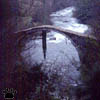
Byzantine bridge,
7th century A.D.,
Ajaria, Georgia. |
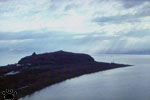
Sacred island (now connected with
mainland), Lake Sevan, Armenia
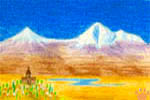
2nd century Christian church, one of
the World's oldest, near Mt. Ararat,
Armenian/Turkish border.
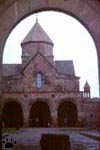
Place of ritual sacrifices,
Echmiadzin, Armenia.

8th century monastery,
Zangelan, Armenia. |
Armenia has suffered the most from foreign invasions.
Since the establishment of satellite Urartu kingdom by Assyrians in 9th century
B.C., the country constantly struggled with surrounding empires. As a result,
most of its territory was lost. Armenia managed to get back at least one small
area during the war with Azerbaijan in 1988-1995, but was flooded with refugees
(Azerbaijan had had large Armenian population). The country is still living in
critical conditions. Surprisingly, its wonderful cultural heritage has largely
survived centuries of war and genocide; the medieval architecture is particularly
impressive.
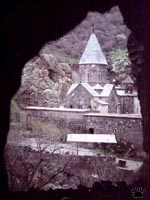
7th century cave monastery,
Geghard, Armenia.
Dozens of churches, cathedrals and monasteries are scattered throughout the Armenian
Highlands. |
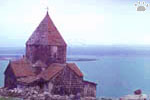
7th century church,
Lake Sevan, Armenia.

Victims of 1988 earthquake still
living in tents and temporal shelters,
Gyumri, Armenia.
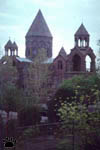
3rd century cathedral,
Echmiadzin, Armenia.
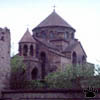
4th century cathedral,
Echmiadzin, Armenia. |

Gentiana sp.,
Aragatz, Armenia. |
Armenia has Mediterranean climate and particularly
diverse flora. It is the place many agricultural plants originate from. Some species
of wild wheat still exist in the vicinity of Yerevan city. There are also many
beautiful and rare flowers in Armenia, mostly
in the southern part along the border with Turkey. |
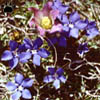
Gentiana sp.,
Dilizhan, Armenia. |

Galanthus albus and Cyclamen coum
ssp.caucasicum,Lake Parzlich,Armenia. |
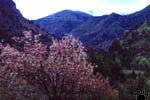
Spring, Hosrov Nature Reserve,
Southern Armenia. |
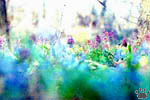
Early spring flowers,
Nagorny Karabakh, Armenia. |
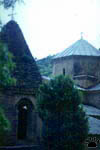
Tbilisi, Georgia. |
Georgia is another open-air museum of architecture,
mostly dating back to 9-14th centuries AD. More recent architecture is also very
original and colorful, particularly in Tbilisi. The old part of the city is a
maze of narrow streets, temples of all religions, small stores and hidden atriums.
The city's unique character, combined with hospitality and tolerance of its people,
made it an artists' Mecca and the important cultural crossroads. Each backstreet
cafe or workshop is reach in history; some stores have signs made by famous artists. |

Tbilisi, Georgia. |
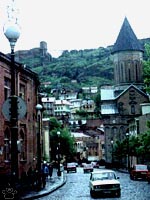
Tbilisi, Georgia. |
The Renaissance started earlier in Transcaucasia
than in Western Europe. In 11-13th centuries,Tbilisi was one of democratic city-states,
with humanistic ideology, flourishing art and literature. For some reason, the
Georgian language is very conservative and hasn't changed much since than: modern
Georgians can easily read books of Classic period. |
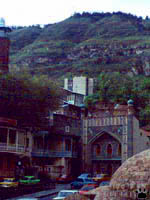
Tbilisi, Georgia. |

Svetitskhoveli Cathedral,
11th century, Mtskheta, Georgia. |
Mtskheta, the ancient capital just west of Tbilisi,
is a good place to see ancient architecture, skilfully placed against beautiful
natural background. |

The interior of Jvari Church,
6th century, Mtskheta, Georgia. |

Crocus georgica,
Poti, Mingrelia,
Georgia |
Georgia consists of about
15 regions, each with its own dialect, culture and nature. Some of the World's
most interesting caves are located in Georgia, Abkhazia
and neighboring parts of Russia. Sataplia Nature Reserve near Kutaisi is the location
of the World's largest collection of dinosaurs tracks. Ancient forests are well
preserved and protected in many parts of the country. |

Velociraptor
track, Imeretia,
Georgia |

Baby Caucasotachea
atrobilata snail,
Kintrishi, Ajaria |
The western part is particularly lush and diverse.
Black Sea coast had been lined by endless swamps and marshes until early 20th
century. Later they were converted into resorts and fields, but some remains are
preserved around Paleostomi lake. Beautiful subtropical rainforests cover the
mountains of Ajaria, Abkhazia and Sochi area of Russia. They shelter many relict
species from Tertiary Period, including more land snails than any other place
on Earth. Eastern Georgia is more dry, there is even a small desert area in Vashlovani
Nature Reserve, known for its reptiles. |
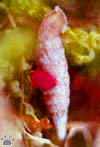
Sanguinus mite on
Cochlicopa snail,
Novy Afon, Abkhazia |
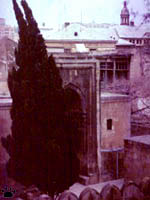
Old city, Baku, Azerbaijan |
Baku, the capital of Azerbaijan,
is a beautiful cocktail of all possible architectural styles, from Medieval Persian
to Baroque and from Byzantine to "Stalin's Soviet". The city used to have equally
diverse cultural life, but, unfortunately, it mostly came to an end with the exodus
of Armenian population in 1988. Most of Russian and Jewish population had also
left the country during the 1990-s. |
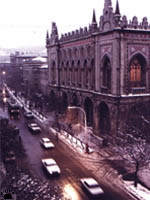
City center, Baku, Azerbaijan |
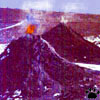
Eruption of mud
volcano, Sumgait,
Azerbaijan |
Surrounding area is a dry wasteland,
dotted with oil pumps and mud volcanoes. There are
more mud volcanoes here than in all other countries together. They come in all
sizes and shapes, and sometimes are very beautiful. Other oil-related phenomena
include eternal gas flames, and tar pits with collections of prehistoric animal
bones - a paleonthological bounty as rich as the famous La Brea tar pits in Los
Angeles, California. |
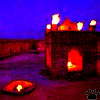
Zoroastrian temple
with eternal gas flames,
Ateshguyakh, Azerbaijan |
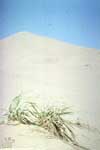
Sarykum Sands,
Lowland Dagestan |
Caspian Sea is mostly surrounded
by desert, except for its southern coast (coastal mountains in Iran and Talysh
in Azerbaijan are covered with dense subtropical rainforests). Rivers entering
the sea create a chain of oasises in the desert, with riparian forests and thousands
of square miles of reed thickets. Word's largest population of sturgeon spawns
in these endless labyrinths of tall golden reeds and clear water. The most interesting
locations are Kyzylagach Bay in Azerbaijan, Agrakhan Bay in Dagestan, Volga delta
in Russia, and the coast of Turkmenistan. |
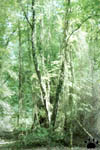
Riparian forest,
Samur, Azerbaijan |
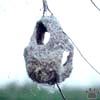
Unfinished nest of
penduline tit (Remiz
pendulinus), Agrakhan
Bay, Dagestan |
Wetlands around the Caspian Sea are prime wintering
areas for birds from all over Eurasia; many rare species nest here as well. The
sea itself is also interesting - its ancient fauna includes many endemics, such
as Caspian seal (Phoca caspica). Taking
a ferry to Baku from Turkmenistan in spring or summer is a good way to see the
seals. |

Red-breasted goose
(Anser ruficollis)
from Taimyr tundras,
Kyzylagach, Azerbaijan |
| Years of Russian control over Caucasus have been
a time of ignorance, racism, and incompetence. Now, with xenophobia and nationalism
at all-times high, Russia is rapidly losing what remains of its influence. No
matter what the outcome of the ongoing wars will be, psychologically most parts
of the Northern Caucasus are already lost for Russia. |
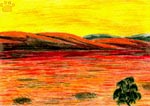
Kura River near Hilly, Azerbaijan. |
These nations will sooner or later become free,
and their spectacular cultures will (hopefully) get rid of imperial unification.
I expect the Caucasus to become again a tourist's paradise, with five-ten peaceful,
exotic, beautiful, independent states, a place to enjoy diversity and hospitality.
I wonder if it will happen in our lifetime. |
Home
|